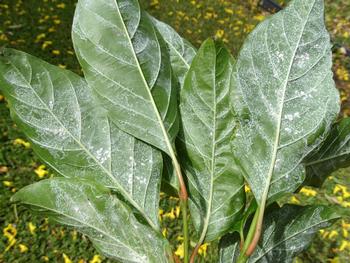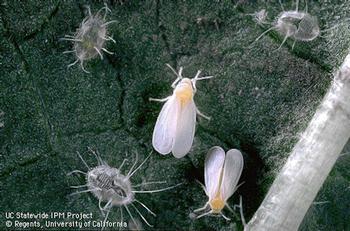Fighting clouds of whiteflies
-
Barbara Robertson
-
Have you ever brushed a plant, and a cloud of white particles flew into the air? Or, noticed veggies like summer squash turning an unappetizing silvery gray?
 An adult female whitefly deposits 200-400 eggs in circles or semi-circular patterns. Whitefly species feed on ~500 species of host plants. Wikimedia
An adult female whitefly deposits 200-400 eggs in circles or semi-circular patterns. Whitefly species feed on ~500 species of host plants. WikimediaIf so, you’ve likely met whiteflies (Homoptera Aleyrodidae) and, in the case of summer squash, a B-biotype species called the Silverleaf whitefly (Bemisia argentifolii). The pests are white, and adults have wings, but they aren’t flies. The little sapsuckers are more akin to aphids, mealybugs, and scale.
There are 1300 whitefly species, perhaps more, that snack on some 500 species of host plants -- garden vegetables, ornamentals, and even cacti. Ranging in size from 1/12th to 1/20th of an inch (1.6 to 2.5mm), they’re smaller than no-see-ums but can damage and, if uncontrolled, even kill plants. They suck out plant juices causing shriveled yellow leaves, stem blanching, and chlorotic spots. They leave behind sooty mold. And they transmit viruses.
Management can work, and natural bio-control is often effective, but pesticides are of less value. The best control is prevention.
This is how they survive. Whitefly adults and nymphs. Many generations of whiteflies in all their stages can live on the undersides of leaves. Photo: UC Regents
Whitefly adults and nymphs. Many generations of whiteflies in all their stages can live on the undersides of leaves. Photo: UC RegentsMale and female adult whiteflies can walk and fly. A female eats and lays eggs simultaneously year-round in warm climates, indoors, and in greenhouses. She sticks her beaky mouthpart into the underside of new leaves, rotates her abdomen around the beak, and deposits 200 to 400 eggs in circles or semi-circles of 30 to 40. Within about a week, greenish-white to dark eggs suspended by short stalks hatch into tiny, flattened, pale-green, almost transparent, oval-shaped nymphs. The nymphs crawl to a good spot, fasten themselves to the underside of the leaf using waxlike rods, and remain immobile. There, they suck sap as they molt until they emerge as adults from their pupa stage.
All whitefly stages are likely present at the same time, with several generations overlapping. Immature whiteflies are difficult to spot, but adults are easy to see when disturbed. The adults resemble tiny white moths with powdery wings that widen to give the insect a triangular shape.
Both nymph and adult whiteflies feed on plant phloem by injecting enzymes and removing sap. To acquire necessary nutrients, they eat large quantities of the sap and then excrete excess liquid and sugar as honeydew. The honeydew can lead to a black sooty mold that grows on leaves, is unsightly, and interferes with photosynthesis. It also attracts ants, and ants protect the whitefly’s insect enemies. An adult female whitefly deposits 200-400 eggs in circles or semi-circular patterns. Whitefly species feed on ~500 species of host plants. Wikimedia
An adult female whitefly deposits 200-400 eggs in circles or semi-circular patterns. Whitefly species feed on ~500 species of host plants. WikimediaControl is difficult because whiteflies hide on leaves’ undersides, reproduce quickly, and flutter away when disturbed. So, before you bring home a plant, shake it to be sure no whitefly clouds appear. Use reflective mulch to protect young plants unless it’s hot.
If you have whiteflies, here are some management techniques:
- Spray the undersides of leaves with water to wash off the whiteflies and honeydew. In University of California studies, side-by-side comparisons with several pesticides indicated that this syringing performed as well or better than chemical treatments.
- Vacuum up the sap-suckers in the early morning. Empty the vacuum bag into a sealed plastic bag, freeze it for 24 hours, and then remove it from your property.
- Buy or make yellow-colored sticky traps.
- Encourage whiteflies’ enemies by filling your garden with flowering plants that attract beneficial insects – particularly tiny parasitic wasps, birds, spiders, lacewings, ladybugs, and big-eyed bugs. You can also buy beneficial insects.
- Prune away infested portions of a plant.
- Control ants with ant stakes or other methods.
- Try insecticidal soaps or horticultural oils. To be effective, coat the underside of all leaves.
- The chemical Imidacloprid, applied annually and absorbed by a plant’s roots, can be effective. But beware: Take precautions to protect bees.
There must be a reason whiteflies exist: they are important in some fauna’s life cycle. If I see them in my garden, though, I’ll be out there with a vacuum in one hand and a hose in the other. For more gardening information of all kinds, see our fabulous website: https://marinmg.ucanr.edu.


